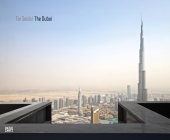 Neuerscheinungen 2014Stand: 2020-02-01 |
Schnellsuche
ISBN/Stichwort/Autor
|
Herderstraße 10
10625 Berlin
Tel.: 030 315 714 16
Fax 030 315 714 14
info@buchspektrum.de |

Nadine Barth, Martino Stierli, Richard Wagner
(Beteiligte)
Tor Seidel
The Dubai. Exhibition: J+A Gallery, Dubai Herbst/Fall 2014. Dtsch.-Engl.-Arab.
Text: Barth, Nadine; Stierli, Martino; Wagner, Richard
2014. 160 S. 75 Abb. 280 x340 mm
Verlag/Jahr: HATJE CANTZ VERLAG 2014
ISBN: 3-7757-3856-8 (3775738568)
Neue ISBN: 978-3-7757-3856-9 (9783775738569)
Preis und Lieferzeit: Bitte klicken
Ansichten eines Künstlers und Bewohners der Megacity
Mit der Entdeckung von Ölvorkommen in den 1950er-Jahren verwandelte sich Dubai rasant. Die Einwohnerzahl stieg binnen kurzer Zeit um 300 Prozent. Auf den höchsten Wolkenkratzer der Wüstenmetropole folgten etliche Vergnügungsparks, 200 künstliche Inseln, Tourismus und Konsum. New Dubai entstand ohne historische Spuren, gestaltete Zentren oder sinnhafte Straßenzüge zum Flanieren. Tor Seidel (geb. 1964 in Rosswein) nähert sich dem fragmentierten urbanen Raum aus einer distanzierten Perspektive, die dem Schein der Kulissen nicht verfällt, sondern auf die Abgründe dazwischen verweist. In seinen Fotografien verflachen etwa gigantische Shoppingmalls vor dem Hintergrund der Tristesse stillgelegter Megaprojekte. Der Künstler belässt uns im Unklaren darüber, ob seine Aufnahmen digital bearbeitet oder Abbildungen der Realität sind. So wird The Dubai zur Allegorie auf die zwischen Versprechen und Desillusionierung schillernde Metropole.
Ausstellung/Exhibition: J+A Gallery, Dubai Herbst/Fall 2014
Dubai was rapidly transformed by the discovery of oil in the nineteen-fifties. Within a brief period the number of inhabitants rose three hundred percent. The construction of the worlds tallest buildings in the desert metropolis was followed by scores of amusement parks, two hundred artificial islands, tourism, and consumption. New Dubai emerged without any historical precedents, a concept of a center, or logical network of streets. Tor Seidel ( 1964) views this fragmented urban landscape from a distance. Resisting the allure of these outward appearances, he points to the yawning gaps in this fa‡ade. In his photographs giant shopping malls are spread out before the melancholy backdrop of mammoth building projects that have been abandoned. The artist does not make clear whether his photographs have been digitally edited or are authentic depictions of reality, and thus The Dubai becomes an allegory of a dazzling metropolis situated between promise and illusion.
Dubai was rapidly transformed by the discovery of oil in the nineteen-fifties. Within a brief period the num ber of inhabitants rose three hundred percent. The construction of the world s tallest buildings in the desert metropolis was followed by scores of amuse ment parks, two hundred artificial islands, tourism, and consumption. New Dubai emerged without any historical precedents, a concept of a center, or logical network of streets. Tor Seidel ( 1964) views this frag mented urban landscape from a distance. Resisting the allure of these outward appearances, he points to the yawning gaps in this fa‡ade. In his photographs giant shopping malls are spread out before the mel ancholy backdrop of mammoth building projects that have been abandoned. The artist does not make clear whether his photographs have been digitally edited or are authentic depictions of reality, and thus The Dubai becomes an allegory of a dazzling metropolis situated between promise and illusion.


